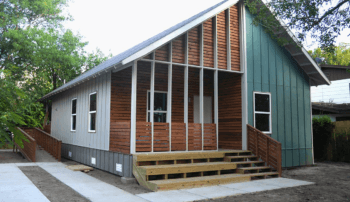Arch Helps Develop Faster Method Of Rebuilding Destroyed Homes

Texas legislators are investigating the benefits of RAPIDO, a pilot program developed with recommendations from Texas A&M Hazard Reduction and Recovery Center, that dramatically reduces the time it takes to rebuild homes destroyed by natural disasters.
The Texas Senate Committee on Intergovernmental Relations is studying RAPIDO and other disaster recovery efforts in Texas to develop policy recommendations prior to the January 2017 state legislative session.
In a Texas Senate hearing on post-disaster housing recovery held last year, a San Benito resident, Amita Melendez, testified that her mother, who had tried for years to rebuild her home that was badly damaged by Hurricane Dolly in 2008, was able to move into a modern, customized home within six months of entering the RAPIDO program.
The program is managed by buildingcommunityWORKSHOP, a Texas-based, nonprofit organization that employs thoughtful design to improve community livability and viability. The group was founded by Brent Brown ’91, who earned Bachelor of Environmental Design and Master of Architecture degrees at Texas A&M.
In developing recommendations for RAPIDO, HRRC researchers reviewed 40 reports detailing obstacles and challenges faced by homeowners trying to rebuild in the wake of Gulf and Atlantic coast hurricanes between 2005-2015.
“One key finding was the need to address long delays faced by those transitioning from temporary housing to permanent housing,” said Shannon Van Zandt, the HRRC research faculty fellow and professor of urban planning who headed the review. “The RAPIDO program was developed to respond to this challenge by helping residents return to their property within three months, then build their home incrementally.”
Van Zandt was assisted by Jaimie Hicks Masterson, an HRRC research assistant, and Master of Urban Planning student Katherine Barbour, who earned a degree in 2015.
Once accepted into the RAPIDO program, families move into pre-assembled modules erected on their property within days of a disaster. Then, the homeowners provide design input for their new homes, which are constructed around the module at a pace and budget they can afford. The process creates a much quicker and more equitable path to permanent housing for low-income residents, who are often most at risk from disasters.
Continue reading from ArchOne.
This article originally appeared in ArchOne.





